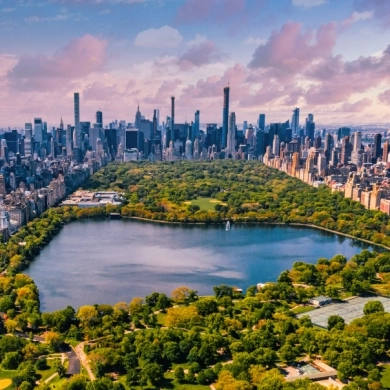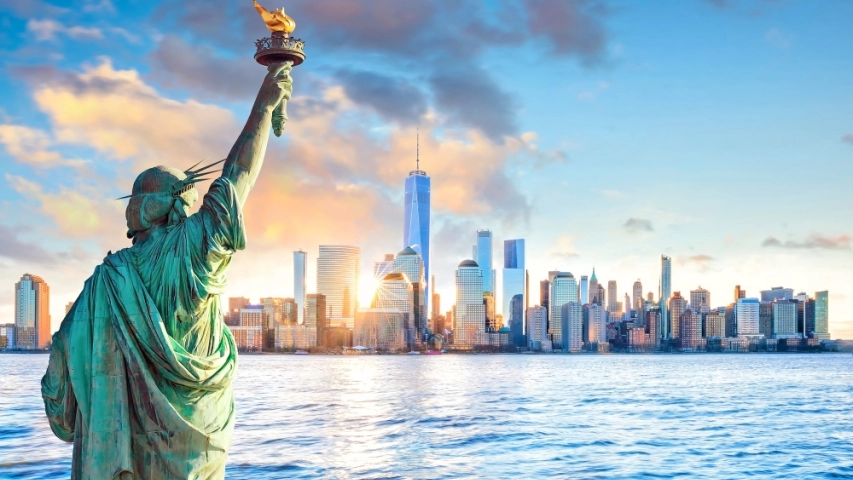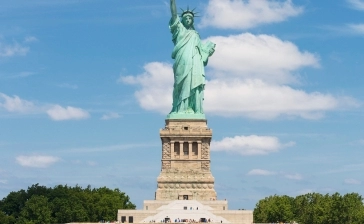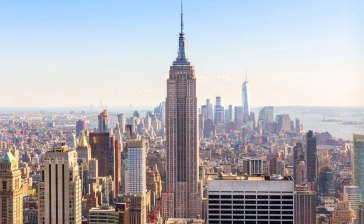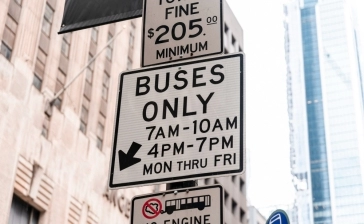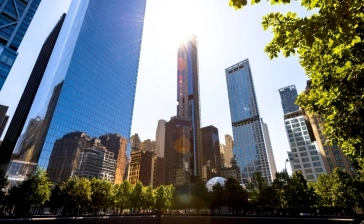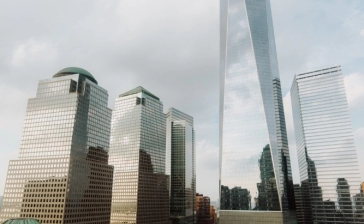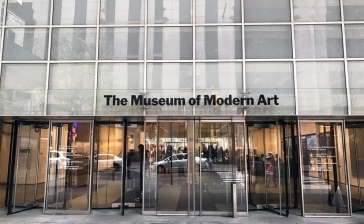New York is the most populous city in the United States and one of the most populous in the world, with an estimated population of 8.5 million people in its central area, but if we add the extended metropolitan area, it totals nearly 24 million inhabitants. Since the late 19th century, it has been one of the centers of world politics and economy, hosting the headquarters of the United Nations and numerous globally significant companies and financial institutions. Additionally, it has a significant global influence in media, politics, education, architecture, entertainment, arts, and fashion. All of this makes it one of the most globalized cities on the planet, with a great cultural diversity.
The city is composed of five boroughs: the Bronx, Brooklyn, Manhattan, Queens, and Staten Island, each of which corresponds to a county. With over 24 million people in an urban area of 830 square kilometers (320 sq mi), New York is the second most densely populated city in the United States, only behind Union City, New Jersey, located across the Hudson River. It is also one of the few cities in the world that houses multiple international institutions without being the political capital of a state.
New York has many iconic places and buildings recognized worldwide, such as the Statue of Liberty, Central Park, Broadway, Times Square, and Wall Street, which is one of the most important financial centers in the world. New York is an exciting and vibrant city, but it can be challenging for people with reduced mobility. Fortunately, the city has taken steps to improve accessibility in recent years.
Most of the city's subway stations now have elevators and wheelchair ramps, making it easier for people with reduced mobility to access them. Additionally, many taxis are equipped with wheelchair ramps, and accessible transportation services are available. City buses also have wheelchair ramps and space for people with reduced mobility. The city's sidewalks are wider and designed to be wheelchair accessible, allowing for easier movement.
Many of the city's major museums and tourist attractions are also accessible to people with reduced mobility, and some offer special guided tours for people with disabilities. The city also has a disability affairs office that can provide information on accessibility and available resources.
Overall, while there may be challenges for people with reduced mobility in New York, the city has made significant efforts to improve accessibility and ensure that everyone can enjoy what it has to offer. The city also has some of the tallest buildings in the world, such as the Empire State Building, One World Trade Center, and Chrysler Building, and undoubtedly, New York is the birthplace of many cultural movements, including hip hop and breakdance.
Undoubtedly, New York is one of the destinations we recommend visiting if you use a wheelchair. Are you ready?
Some interesting facts about New York:
- New York is the most populous city in the United States.
- The currency used in the United States is the Dollar $.
- Its time zone is GMT - 5.
- The Statue of Liberty is one of the most well-known symbols of the city and the country. It was a gift from the French people in 1886 and is located on Liberty Island.
- Central Park is one of the largest urban parks in the world, covering an area of over 840 acres.
- The city of New York is considered one of the most cosmopolitan cities in the world, with a great variety of cultures and languages present in its population.
- The city has a wide range of cultural offerings, such as the Metropolitan Museum of Art, the Museum of Modern Art (MoMA), the American Museum of Natural History, and the Metropolitan Opera House, among others.
- The city's public transportation system, the subway, is one of the largest and most extensive in the world, with 472 stations and over 340 kilometers of tracks.
- Some of the most well-known foods include pizza, bagels, hot dogs, hamburgers, and cheesecake.
New York has numerous tourism offices that can provide information about the city's attractions and activities.
Regarding wheelchair accessibility, many of the tourism offices in New York are located in accessible buildings and are equipped to assist visitors with special needs. Additionally, the city of New York has an accessibility law that requires businesses and public buildings to be accessible to people with disabilities.
Official NYC Information Center at Macy's Herald Square
Located within the world's largest department store, the Official NYC Information Center at Macy's Herald Square is more than just a visitor center. In addition to city specialists who are there to answer any questions you may have, the center also features touchscreen information kiosks to help you plan your trip, with Google maps and the ability to print directions; a multitude of guides and maps; and tickets to various attractions (many with discounts). Visitors can also enjoy a 10% visitor shopping pass discount at Macy's, which can be obtained for free from center specialists or by using a driver's license or passport at one of the kiosks.
Located within the main Macy's store on 34th Street between Seventh Avenue and Broadway, the center is convenient not only for many subway lines, but also for the Long Island Rail Road, New Jersey Transit, and Amtrak, which operate in and out of Penn Station across the street. Additionally, 34th Street is a major shopping hub in Manhattan and the site of several flagship stores.
- Address: 151 W. 34th St. (between Seventh Avenue and Broadway)
- Metro lines: 1, 2, 3, A, C, E to 34th St.-Penn Station; B, D, F, M, N, Q, R to 34th St.-Herald Sq.
- Hours: Monday to Friday: 9am–7pm; Saturday: 10am–7pm; Sunday: 11am–7pm.
- Closed on Thanksgiving Day and Christmas.
- Contact phone: (+1) 2124943827 or (+1) 212-639-9675
NYC Information Center – Times Square
The Official NYC Information Center at Times Square offers visitors guides, maps, brochures, pamphlets, coupons, and discounts related to everything there is to do and see in the city, with bilingual staff available to provide further guidance. The kiosk, in a plaza on the east side of Seventh Avenue between 44th and 45th streets, is convenient for many Midtown attractions, and is also at the intersection of many subway stops, allowing you to hop on a train and head almost anywhere after picking up all the information you need about the five boroughs.
- Address: Seventh Avenue (between 44th and 45th streets)
- Metro lines: 1, 2, 3, 7, A, C, E, N, Q, R, S to 42nd St.-Times Square
- Hours: Daily from 9am to 6pm.
- Closed on Thanksgiving Day and Christmas.
NYC Information Center at City Hall
This center provides visitors with guides, maps, brochures, pamphlets, coupons, and discounts related to everything to see and do in the city, with bilingual staff available for further guidance. Located at the southern tip of City Hall Park on the Broadway sidewalk at Park Row, the center is convenient for many attractions in the Financial District, Battery Park City, TriBeCa, and South Street Seaport, and is also at the intersection of many subway stops, allowing you to hop on a train and head almost anywhere after picking up all the information you need about the five boroughs.
- Address: Southern tip of City Hall Park on the Broadway sidewalk at Park Row.
- Metro lines: 2, 3 to Park Place; 4, 5, 6 to Brooklyn Bridge-City Hall; 2, 3, 4, 5, A, C, J, Z to Fulton St.; J, Z to Chambers St.
- Hours: Monday to Friday: 9am-6pm; Saturday-Sunday: 10am-5pm.
- Closed on Christmas Day.
NYC Information Center at South Street Seaport
This center has city specialists available to answer any questions you may have. The center is also equipped with touch-screen kiosks to help you plan your trip, with information on attractions, restaurants, nightlife, and other areas of interest in the city's five boroughs. The center also offers attraction passes (City Pass, Explorer Pass, and NY Pass), hop-on-hop-off bus tours, and ticket sales for over 80 major attractions and events, as well as official NYC & Company visitor guides and maps.
- Address: Hornblower Cruises on the East River Waterfront Esplanade (Pier 15).
- Metro lines: 2, 3, A, C, J, Z to Fulton St.
- Hours: May to August, daily from 9am to 7pm; September to April, daily from 9am to 5pm.
- Closed on Christmas Day.
Tourist passes with access to transportation:
In New York City, you can access several tourist passes that include access to public transportation, as well as entry to popular attractions in the city. Some of the most popular tourist passes that offer access to public transportation are:
New York Pass: This pass includes free entry to over 100 popular attractions in the city, as well as unlimited access to the city's public transportation, including buses, trains, and the MTA subway.
New York Explorer Pass: This pass allows you to choose between 2, 3, 4, 5, 7, or 10 popular New York attractions to visit, and also includes access to the city's public transportation during the validity period of the pass.
CityPASS: This pass offers access to six top attractions in New York, including the Empire State Building and the American Museum of Natural History, as well as a 9-day ticket for unlimited access to New York City's public transportation.
Sightseeing Pass: This pass includes entry to over 100 popular attractions in the city, as well as unlimited access to New York City's public transportation.
It is important to review the options of each pass to determine which one is the best option according to your travel needs and preferences.
Airports:
New York has 3 airports: John F. Kennedy International Airport (JFK), LaGuardia Airport (LGA), and Newark Liberty International Airport (EWR), with JFK being the most important and busiest airport.
Each airport is wheelchair accessible and free assistance services are provided for disabled passengers. Personal wheelchairs and other mobility equipment can be taken to the gate and plane door. All airlines provide services for people with disabilities at each airport according to the Air Carrier Access Act.
JFK: It is important to know that this airport is the largest gateway to the United States. John F. Kennedy International Airport (JFK) is the largest airport in New York, with over 53 million passengers passing through it in 2014, and in 2021 (after the pandemic) there were 24 million passengers who traveled through JFK. It can be said that it is the largest gateway for international traffic to and from the United States.
Regarding accessibility, JFK has several points of assistance for people with reduced mobility. Here are some of them:
- Arrivals area: Passengers who need assistance can request it at the information desk located in the arrivals terminal.
- Departures area: Passengers who need assistance can request it at the information desk located in the departures terminal.
- Parking area: Passengers can request assistance at the information desk located in the parking area for people with disabilities.
- Security area: In the security area, there is trained security personnel to provide assistance to passengers with disabilities.
- Boarding area: At the time of boarding, airline staff is trained to provide assistance to passengers with disabilities.
The airport has 6 terminals, numbered from 1 to 8 (skipping 3 and 6). The terminals operate independently of each other, with the exception of terminals 2 and 4, which are connected by an inter-terminal shuttle bus, the JFK Jitney. Passengers connecting between other terminals must exit the terminal, use a curbside shuttle bus (which is wheelchair accessible), and go through security again. If you are traveling with a single airline, their domestic flights will operate from the same terminal, with the exception of Delta Air Lines, which uses terminals 2 and 4. These are connected in the security zone through the Jitney bus.
Assistance services for people with disabilities must be requested through their airline. The airport bathrooms are equipped with accessible stalls for wheelchairs. Some terminals have private bathrooms designed for use by wheelchair users and their companions. The size of the airport terminals can result in significantly long walks between gates. Terminal 4 is over a mile half long.
Transportation to and from the airport:
Accessible Metro (AirTrain):
The primary and most efficient public transportation option at JFK is the AirTrain JFK. This train stops at all terminals (follow signs posted in the baggage claim area). The AirTrain only travels to the Jamaica station but connects with the Long Island Rail Road (LIRR), which provides service to Manhattan and other districts of New York City. It is wheelchair accessible and has reserved space on each train. When taking the subway, make sure to check the accessibility of the stations and the schedules of the accessible trains.
The Jamaica line stops additionally at Federal Circle and Jamaica stations, while the Howard Beach route stops at Federal Circle, Lefferts Boulevard, and Howard Beach stations.
From the Jamaica station, connections are available to the E, J, and Z lines of the New York City subway; Long Island Rail Road (LIRR); and New York City/MTA bus lines Q6, Q8, Q9, Q20A, Q20B, Q24, Q25, Q30, Q31, Q34, Q40, Q41, Q43, Q44, Q60, and Q65. LIRR trains offer the fastest service from Jamaica station to New York-Pennsylvania station.
From the Lefferts Boulevard station, connections are available to MTA bus line Q10 and New York City Transit Bus B15.
From the Howard Beach station, connections are available to the New York City subway A line and MTA bus Q11.
Using the AirTrain between terminals is free, but service to Jamaica, Lefferts Boulevard, and Howard Beach stations costs $5.00 per trip.
Bus:
Another accessible and relatively inexpensive option is the NYC Airporter shuttle bus. The NYC Airporter offers ADA-accessible buses with lifts and wheelchair security devices. Fares from JFK to Manhattan start at $16.00 per trip. NYC Airporter counters are available at JFK airport terminals where you can get information and buy tickets. The counters are located in Terminal 1, Terminal 4, and Terminal 8.
Contact information for NYC Airporter at JFK Airport:
Taxi:
It's the most expensive option, but it's also the most comfortable if you arrive at JFK in a wheelchair and want to go to downtown New York. To request an accessible taxi, you can go to the taxi stand at each terminal of the airport and ask for one. You can also call an accessible taxi company and book a taxi in advance (recommended).
Some accessible taxi companies in New York include Accessible Dispatch, NYC Wheelchair Taxi, and Metro Mobility. Remember that the price of an accessible taxi from JFK airport to downtown New York may be higher than the cost of a conventional taxi. In addition to the standard taxi fare, an additional fee may be charged for the use of the ramp or elevator for wheelchairs.
We provide you with the contact information for the NYC Wheelchair Taxi accessible taxi company in New York:
Transportation within the city:
Train:
Many of the trains in New York are adapted for wheelchair users, although accessibility may vary by line and station. Most trains in New York have accessible cars with specific areas for people with disabilities and their companions, as well as accessible stop buttons and audio announcements to inform visually impaired passengers about upcoming stops. However, like the subway, not all train stations in New York are wheelchair accessible. Some stations have elevators or ramps to access train platforms, while others do not. Therefore, it is important to check the accessibility of train stations in advance and plan your trip accordingly.
Subway:
The New York subway has some stations and cars adapted for wheelchair users, although not all stations are accessible. Accessible stations usually have elevators or ramps to access subway platforms, and some cars have specific areas for people with disabilities and their companions. However, some stations may not have adequate access for wheelchair users, so it is recommended to plan ahead and check the accessibility of stations before traveling.
Bus:
Most buses in New York are adapted for wheelchair users. Accessible buses have automatic ramps for wheelchair users to easily board and exit the bus. In addition, there are designated spaces for wheelchairs and other mobility devices on buses, and seats near these spaces fold up to provide enough space for wheelchair users to maneuver. There are also accessible stop buttons and audio announcements to inform visually impaired passengers about upcoming stops.
Taxi:
Yes, in New York, accessible taxis are available for people with disabilities. The city of New York has an accessible taxi program that ensures that at least 50% of yellow taxis (typical New York taxis) are equipped with ramps or elevators and special seats for passengers with disabilities. Accessible taxis are also available through the New York City accessible taxi service, known as "Access-A-Ride." This service provides door-to-door transportation for people with disabilities who cannot use public transportation. In addition, there are taxi and ride-sharing services (such as Uber and Lyft) that offer accessible vehicle options in New York City.
When making an online reservation, users can specify if they need an accessible vehicle for people with disabilities.
Contact for Access-A-Ride:
Manhattan Neighborhood:
Manhattan is one of the five boroughs that make up New York City and is a popular tourist destination due to its vibrant atmosphere, impressive architecture, and a wide range of attractions and activities. While Manhattan is a city that can be very accessible for people with disabilities, there are still challenges that wheelchair users face, such as the lack of ramps in some areas, poor sidewalk conditions, and narrow stores.
However, many parts of Manhattan have been designed to be accessible for people in wheelchairs. Most subway stations are equipped with elevators, and some streets have ramps. In addition, many tourist attractions and places of interest have also improved their accessibility for people with disabilities, with step-free entrances, accessible bathrooms, and other services that cater to their needs.
One of the most popular places in Manhattan is Central Park. This huge public park has many trails and paths that are accessible for people in wheelchairs, allowing visitors to enjoy the natural beauty of the park. In addition, there are numerous attractions in the park that are also accessible, such as the Central Park Zoo, which has ramps and elevators to allow access for people with disabilities.
Another popular attraction in Manhattan is the Metropolitan Museum of Art, which has more than two million works of art from around the world. The museum has multiple entrances, each of which is equipped with a ramp, and offers accessible tours for people with disabilities. The museum also has accessible bathrooms and a transportation service that allows wheelchair users to move around the museum easily.
Broadway's theater district also offers accessible options for people in wheelchairs. Many theaters have ramps to access their seats, and some have special areas for wheelchairs. Shows also offer sign language interpretation and audio description services, allowing people with visual or hearing impairments to enjoy the theatrical experience.
The American Museum of Natural History is another place in Manhattan that is accessible for people in wheelchairs. The museum has step-free entrances and elevators to allow access to the different galleries. There are also accessible bathrooms and wheelchairs available for use in the museum.
One of the best ways to experience Manhattan is simply to walk its streets and enjoy the architecture and atmosphere of the city. However, it is important to note that not all sidewalks and streets are accessible for people in wheelchairs. Narrow sidewalks and potholes can make it difficult to move around in some areas. In addition, traffic and crowds in some parts of Manhattan can be a barrier for wheelchair users.
For those who want to experience the thrill of shopping in Manhattan, many stores have improved their accessibility for people in wheelchairs. Department stores like Macy's have accessible entrances and elevators, and many stores have widened their aisles to allow for easier wheelchair navigation.
The Smith - East Village: https://thesmithrestaurant.com
This is a chain of American restaurants, and the East Village location was the first one, opened in 2007. At this restaurant, you will find everyone from families and nearby students to weekend brunch-goers and late-night revelers. It has a step-free entrance and accessible bathrooms.
Its hours are Monday to Thursday 8:30 AM to 11:00 PM / Friday and Saturday 9:00 AM to 12:00 AM / Sunday 9:30 AM to 11:00 PM.
Address and contact:
- 55 Third Avenue, New York (between 10th and 11th street)
- Phone: (+1) 2124209800
Carmine's - Upper West Side: https://www.carminesnyc.com/
At this restaurant, you will feel at home, and that's because at Carmine's you will find locals, office workers, and groups of friends enjoying excellent and plentiful Italian food. This Italian restaurant has a step-free entrance and accessible bathrooms.
Its hours are Monday to Sunday 11:30 AM to 10:00 PM.
Address and contact:
- 2450 Broadway, New York, NY 10024
- Phone: (+1) 212-362-2200
Tao Downtown: https://taogroup.com/
This Asian restaurant is fully accessible to people with reduced mobility thanks to its step-free entrance and accessible bathrooms. Additionally, hidden inside the TAO Downtown restaurant is a hidden gem and an oasis known as the TAO Downtown Nightclub.
Separated from the restaurant, it has maintained a discreet profile, attracting celebrities and where you can have a drink, relax, and enjoy until late at night.
The opening hours of TAO Downtown's restaurant are as follows:
Monday to Thursday: 5:00 PM to 11:00 PM. Friday and Saturday: 5:00 PM to 12:00 AM. Sunday: 5:00 PM to 10:00 PM.
Address and contact:
